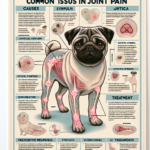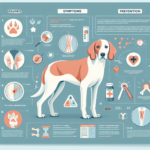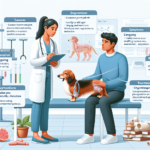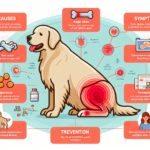Pug Joint Pain: Causes, Symptoms, Prevention, and Treatment

Introduction
Pugs are a beloved breed known for their distinctive wrinkled faces, compact bodies, and charming personalities. Originating from China, Pugs have a rich history dating back to the Han Dynasty (206 B.C. to A.D. 200). They were prized by Chinese emperors and later became popular in Europe, particularly in the Netherlands and England. Pugs are characterized by their short-muzzled faces, large expressive eyes, and curly tails. Despite their small size, they have a sturdy build and a playful, affectionate nature.
Like many purebred dogs, Pugs are prone to certain health issues. Common concerns include respiratory problems due to their brachycephalic (short-nosed) structure, skin infections in their facial folds, and eye conditions like proptosis. Among these, joint pain is a significant issue that can affect their quality of life.
Joint health is crucial for Pugs because their unique body structure and genetic predispositions make them susceptible to joint-related problems. Ensuring good joint health can help prevent pain, improve mobility, and enhance the overall well-being of these charming companions.
Breed-Specific Joint Pain Risks
Genetic Predisposition
Pugs have a genetic predisposition to several joint-related issues. Hip dysplasia, a condition where the hip joint doesn’t fit properly into the hip socket, is relatively common. This can lead to arthritis and significant pain over time. Elbow dysplasia, where the elbow joint is malformed, is another concern. Additionally, Pugs are prone to patellar luxation, a condition where the kneecap dislocates from its normal position.
Age-Related Risks
As Pugs age, the risk of joint pain increases. Degenerative joint diseases like osteoarthritis become more prevalent in older Pugs. Typically, signs of joint pain may start appearing around middle age, which for Pugs is around 5-7 years old. However, some Pugs may show symptoms earlier, especially if they have a genetic predisposition or have experienced joint injuries.
Activity Level and Joint Stress
Pugs are not as active as some other breeds, but they still enjoy playtime and short walks. However, their compact and heavyset bodies can put extra stress on their joints, especially if they are overweight. Activities that involve jumping or sudden movements can exacerbate joint issues. It’s essential to balance their activity level to avoid overexertion while keeping them fit and healthy.
Common Symptoms of Joint Pain in Pugs
General Symptoms
- Limping: One of the most noticeable signs of joint pain is limping or favoring one leg over another.
- Stiffness: Pugs may show stiffness, especially after resting or sleeping.
- Reluctance to Move: A Pug with joint pain may be hesitant to climb stairs, jump onto furniture, or go for walks.
- Decreased Activity: Reduced interest in play and exercise can be a sign of discomfort.
- Behavioral Changes: Irritability or aggression when touched or moved can indicate pain.
Breed-Specific Symptoms
In Pugs, joint pain may also manifest as a reluctance to engage in activities they previously enjoyed, such as playing with toys or interacting with family members. Due to their expressive faces, you might notice changes in their facial expressions, indicating discomfort.
When to Consult a Vet
If you observe any of the above symptoms, it’s essential to consult a veterinarian. Early intervention can prevent further deterioration and improve your Pug’s quality of life. Regular check-ups are crucial, especially as your Pug ages or if they have a known genetic predisposition to joint issues.
Preventive Measures for Joint Health
Exercise Recommendations
Regular, moderate exercise is vital for maintaining joint health in Pugs. Short walks, gentle play sessions, and swimming are excellent options. Avoid high-impact activities like jumping or running on hard surfaces. Consistent, low-impact exercise helps keep their muscles strong and supports joint function.
Dietary Suggestions
A balanced diet rich in essential nutrients can support joint health. Look for dog foods that contain glucosamine and chondroitin, which help maintain cartilage. Omega-3 fatty acids, found in fish oil supplements, can reduce inflammation and support joint health. Always consult your vet before adding supplements to your Pug’s diet.
Weight Management
Maintaining a healthy weight is crucial for reducing joint stress. Pugs are prone to obesity, which can exacerbate joint problems. Monitor their weight closely and adjust their diet and exercise routine as needed. Your vet can provide specific guidelines for your Pug’s ideal weight and caloric intake.
Early Screening and Monitoring
Regular veterinary check-ups are essential for early detection of joint issues. Your vet may recommend screening tests like X-rays or joint fluid analysis, especially if your Pug has a genetic predisposition. Early diagnosis allows for timely intervention and better management of joint health.
Treatment Options for Joint Pain
Non-Surgical Treatments
Non-surgical treatments are often the first line of defense against joint pain. These may include:
- Medications: Anti-inflammatory drugs and pain relievers can help manage pain and reduce inflammation.
- Physical Therapy: Specialized exercises and therapies can improve joint function and reduce pain.
- Lifestyle Adjustments: Modifying your Pug’s activity level and environment can help manage symptoms.
Surgical Options
If non-surgical treatments are ineffective, surgical interventions may be necessary. Common surgeries for joint issues in Pugs include:
- Hip Replacement: Replacing the damaged hip joint with an artificial one.
- Arthroscopy: A minimally invasive procedure to clean out the joint and remove damaged tissue.
- Osteotomy: Cutting and realigning bones to improve joint function.
Surgery should be considered a last resort and discussed thoroughly with your veterinarian.
Alternative Therapies
Alternative treatments can complement traditional therapies and provide additional relief. These may include:
- Acupuncture: This ancient practice can help reduce pain and improve mobility.
- Hydrotherapy: Water-based exercises that reduce joint stress while improving strength and flexibility.
- Massage: Regular massages can help alleviate muscle tension and improve circulation.
Lifestyle and Management Tips
Daily Care Routine
A consistent daily care routine can help manage joint pain in Pugs. This might include:
- Short, gentle walks twice a day.
- Regular, low-impact play sessions.
- Administering prescribed medications and supplements.
- Providing a balanced diet and monitoring weight.
Modifying the Home Environment
Making your home more comfortable for a Pug with joint pain can significantly improve their quality of life. Consider the following modifications:
- Install ramps to help them access furniture or climb stairs.
- Provide orthopedic beds to support their joints while resting.
- Ensure food and water bowls are at a comfortable height to reduce strain.
Long-Term Management
Long-term management of joint pain involves regular veterinary check-ups, consistent exercise, and a balanced diet. Monitoring your Pug’s condition and adjusting their care routine as needed can help them stay active and happy despite joint pain.
FAQs About Pugs and Joint Pain
What are the early signs of joint pain in Pugs?
Early signs include limping, stiffness, reluctance to move, decreased activity, and behavioral changes like irritability.
Can joint pain in Pugs be prevented?
While genetic predispositions can’t be changed, maintaining a healthy weight, providing regular exercise, and a balanced diet can help prevent or delay the onset of joint pain.
Are there specific exercises that are better for Pugs with joint pain?
Low-impact exercises like short walks and swimming are ideal. Avoid high-impact activities that can stress the joints.
What dietary supplements can help with joint health in Pugs?
Supplements containing glucosamine, chondroitin, and omega-3 fatty acids can support joint health. Always consult your vet before adding supplements to your Pug’s diet.
When should I consider surgery for my Pug’s joint pain?
Surgery should be considered if non-surgical treatments are ineffective and your Pug’s quality of life is significantly affected. Discuss all options with your veterinarian.
Conclusion
Joint pain is a common issue in Pugs, but with proper care and management, you can help your furry friend live a comfortable and active life. Regular exercise, a balanced diet, weight management, and early screening are crucial preventive measures. If joint pain does occur, a combination of non-surgical treatments, surgical options, and alternative therapies can provide relief. Always consult your veterinarian for personalized advice and treatment plans. By taking proactive steps, you can ensure your Pug enjoys a happy, healthy life.




